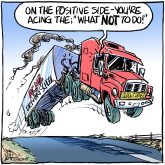Ad hoc farm support used to be a messy, acrimonious affair. These days, the feds, the provinces and the major farm groups are all on the same page playing nice. There’s nary a dissenting voice.
In case you’ve forgotten, here’s how it used to be. A need would arise, be it drought, flood or especially ugly grain prices.
Farm groups and the provinces would call for federal assistance and the feds would delay and provide 101 excuses why they couldn’t react. Their top reason was usually that existing farm safety nets should be adequate.
Read Also

Welcome to the Farm Show a new way to tell vital stories
The Welcome to the Farm Show documentary series is a new way to tell important stories that the Western Producer is experimenting with and that I think you’re going to like.
Over the years there have been treks to Ottawa, petitions, letter writing campaigns and massive rallies. In the instances when Ottawa was eventually shamed into coming up with an assistance program, it would be widely criticized as being too little, too late with bad program design.
That mould has been broken in the past couple years as governments have reacted to unprecedented flooding. In last week’s announcement, nothing was left to chance.
The setting was right – a farm near McTaggart in southeastern Saskatchewan, in the epicentre of the unseeded acreage problem.
The feds and the provinces weren’t at each other’s throats. It was a joint announcement without any visible arguments.
Supportive farm groups were enlisted to praise the announcement. Many of the news releases were pre-written and ready to go. It was a little embarrassing when the Canadian Cattlemen’s Association sent a news release praising the assistance package well in advance of the actual announcement, but that was a minor glitch.
In reality, the package is praiseworthy. In Saskatchewan, the crop insurance unseeded acreage benefit for this year had already been increased to a maximum of $70 from $50.
Still, the two levels of government will come up with an additional $30 an acre for unseeded land as well as seeded land that was flooded before July 31 – the same amount that was paid last year.
In total, nearly half a billion dollars was committed.
Livestock is also part of the plan. There’s even recognition of the wet weather problems in feedlots.
The money is flowing from the nebulous program called AgriRecovery. It’s really just the old ad hoc approach with a fancy name. No matter what you call it, there is some merit in tailoring assistance to unique situations. In this instance, it’s the second year of reacting to flooded land, so governments had a template developed to deal with the situation.
There was seldom any doubt that a program similar to last year’s would be announced. Even farm groups that don’t like the Harper government waited patiently.
It should be noted that this $448 million in federal and provincial money will reduce the amount that eventually flows in AgriStability payments.
AgriStability reacts long after an income shortfall is suffered and each producer is affected differently, so this money will be useful even if it offsets later payments.
It’s a bit disconcerting that the feds are actively orchestrating positive farm group reaction for their announcements. There’s a danger of farm groups become too cozy with government. They can’t be afraid to say things that are less than complimentary when that’s the proper reaction.
Still, the current environment sure beats the old days.
Kevin Hursh is an agricultural journalist, consultant and farmer. He can be reached by e-mail at kevin@hursh.ca.















